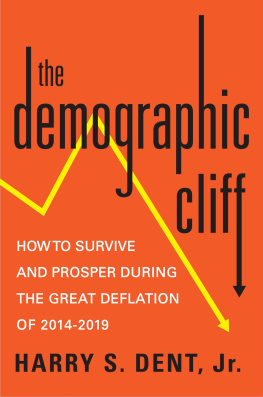USA | Canada | UK | Ireland | Australia | New Zealand | India | South Africa | China
First published by Portfolio / Penguin, a member of Penguin Group (USA) LLC, 2014
Copyright 2014 by Harry S. Dent, Jr.
Penguin supports copyright. Copyright fuels creativity, encourages diverse voices, promotes free speech, and creates a vibrant culture. Thank you for buying an authorized edition of this book and for complying with copyright laws by not reproducing, scanning, or distributing any part of it in any form without permission. You are supporting writers and allowing Penguin to continue to publish books for every reader.
Figures : Hoisington Investment Management Co.
And posthumously... my courageous father,
Harry S. Dent, Sr.
INTRODUCTION
Im not usually on the bearish side of predictions, having been an outspoken bull since the late 1980s. I was watching the rise of the massive Baby Boom and thinking optimistically when most economists saw the United States declining after the first financial peaks of the 1980s. I anticipated the decline of Japan in the 1990s when economists were proclaiming it would overtake the U.S. economy. Now people are saying the same thing about Chinas growth in the next decade, despite the fact that Japans economy remains virtually comatose two decades later.
At Dent Research we have a not-so-secret weapon: demographics. It is the ultimate indicator that allows you to see around corners, to predict the most fundamental economic trends not just years but decades in advance. Demographic data can help identify macro and micro trends. On the small side, I can tell you when people spend the most on potato chipsage forty-two. Thinking bigger, I can point out to you how our economy has boomed and gone bust on a forty-six-year lag tied to the birth index for peak spending of the average family since 1983.
I believe, in short, that if you understand the demographic data, using it to your advantage just isnt that difficult.
Inflation rises with younger people entering the workforce, then wanes after they become most productive in their forties. Deflation can set in when more people retire than enter the workforce (thats happened in Japan). Younger people drive innovation cycles, older ones dont (there are more adult diaper sales in Japan today than sales of baby diapers!). Demographics are the key to the future: if you dont understand such trends, from the trivial to the tremendous, you will miss many things that you should have seen coming.
Many economists refuse to see beyond the next election. They see political factors as central, but I disagree. The key to the future is the predictable things people doand, for the most part, politicians are merely reacting on a lag. By understanding the demographics, we can identify the key economic trends that will affect our lives, businesses, and investments during our lifetime.
The Debt Drug and Other Problems
In response to the global economic panic in 2008, governments around the world pulled out all the stops, stimulating beyond anything imaginable years ago. Governments and central banks employed quantitative easing (QE), a new debt drug that involves buying financial assets to increase the monetary base$11 trillion and rising globally. The goal was to prevent a continuing global slowdown by deleveraging the greatest debt and financial asset bubble in history.
But this practice perverts markets, interrupting the free markets natural mechanisms for rebalancing and fostering innovation. This messing with Adam Smiths invisible hand means you need to prepare for the worst downturn and crash of your lifetime, which I predict will arrive in early to mid-2014. Governments are going to keep drugging themselves with QE until they fail and the economy corrects itself between 2014 and 2019, when all of my key cycles point down togetherIve never seen a cycle alignment like this before. Since 1983 the private sector of the United States alone has accumulated $42 trillion in private debt (it grew at 2.7 times GDP for twenty-five years), but we cant keep growing government debt forever in the name of supporting the now slowing private economy. When the economy corrects itselfand it willtherell be a sudden deflation in prices. Financial asset bubbles will burst all around us, just as we saw in late 2008 before government stimuli brought it to a halt.
Lets take another demographic angle. Record real estate prices around the world arent good for the economy because they raise the cost of living and the cost of business. When you look closely at the numbers, its apparent that older households benefited the most from the 20002005 bubble. But if we want the younger generation to invest for the future, we need real estate and stock prices to come back down to reality. We need debt levels to be written down so households and businesses can free up cash flow and afford to expand again.
Speaking of our aging population, we also need to get real about the simple fact that our life expectancies have risen dramatically over the last several decades. Too many of us still aspire to retire in our early sixties when we should be thinking of retiring in our early seventies. If we accept the truth of that, we solve much of the massive entitlement crisis we face with fewer and fewer workers and more and more retirees. In fact, retirement is a myth created in the last several decades. Unless your health is failing, why retire and do nothing? Contributing and serving people is what we humans are all about, not sipping martinis at the pool!
We have seen an unprecedented boom for the last three-quarters of a century. Special interests have created all types of tax loopholes and health care inefficiencies that need to be revolutionized, not changed by increments. Then theres education, the highest inflation sector of our economy. There is no way to fix our unbelievably complex tax code or health care or education systems with incremental political change. The only way we get such a revolution is a breakdown of the system that has worked so well for decades and even centuries. How do we get there?
The Four Seasons
Demographics and the pace of technological innovation can be used to predict what is to come. In the pages that follow, Ill outline a simple, four-season cycle with a duration roughly that of the human lifetime of about eighty years.
New technologies and generational boom-and-bust cycles create a sustained boom that starts in the spring, hits speed bumps in summer with high inflation (think high temperatures) and falling generational spending that then descends into an autumn bubble boom with rising generational spending and productivity, falling inflation and interest rates. That final boom creates bubbles in financial assets and new technologies and business models that, like after the fallow season of winter, will pay off for many decades to follow, but must first get more efficient by means of the deleveraging of debt bubbles and financial assets (as happened in the 1930s and will occur in the decade ahead).















